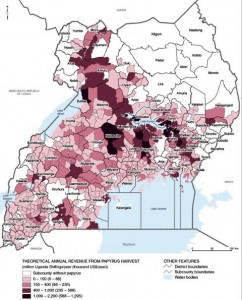A modest proposal from the Network Semences Paysannes:
Levy a tax on the sale of seeds which cannot be freely reproduced, and earmark the money for the financing of seed houses and collaborative breeding programmes.
That’ll work.
Agricultural Biodiversity Weblog
Agrobiodiversity is crops, livestock, foodways, microbes, pollinators, wild relatives …
A modest proposal from the Network Semences Paysannes:
Levy a tax on the sale of seeds which cannot be freely reproduced, and earmark the money for the financing of seed houses and collaborative breeding programmes.
That’ll work.
An opinion piece in the Awareness Times of Sierra Leone decries the current parlous state of Rokupr Agricultural Research Station. It starts, however, by waxing lyrical abut the past.
Established about half a century and decade ago, the Rokupr Rice Research Station was a darling vision of the early colonialists who among other considerations were fascinated by the fertile ecologies and enviable terrain of the Scarcies coastline… With rice as a popular diet in West Africa and around the world, Sierra Leone in the shadows of Rokupr Rice Research was put on the spot light of fame and popularity. Rokupr became internationally known.
Indeed. And not only for rice breeding, but also for being at the forefront of the scientific thinking about on-farm conservation of plant genetic resources in the 1990’s, as part of the Community Biodiversity Development and Conservation Project. Alas,…
…[t]he present condition of Rokupr Rice Research is dismal. The one time elegant roads in the station premises are presently all gorges and death traps. The compound remains uncared for. Trees, shrubs and grass have overgrown and form a canopy over the compound. The trees are dens for giant snakes and other poisonous pests. Research trial fields are abandoned. There are no resident senior staffs and research activities have been suspended for ages. The compound looks marooned and deserted. The aura of research is dilapidated. Laboratories and staff quarters are ransacked and in dear need of renovation. Staff morale, dedication, and motivation are low and devoid of promise.
A pity, especially since an alumnus of the station was minister of agriculture until fairly recently. Who will save Rokupr?
Want to know where Ugandans can make the most money from harvesting papyrus? Here you go:

This map is one of a whole series on Ugandan wetlands — their potential and the threats they face — that has just been published by the World Resources Institute 1 under the title Mapping a Better Future: How Spatial Analysis Can Benefit Wetlands and Reduce Poverty in Uganda.
One of the co-authors, Paul Mafabi , commissioner of the Wetlands Management Department in Uganda’s Ministry of Water and Environment, had this to say at the launch:
These maps and analysis enable us to identify and place an economic value on the nation’s wetlands. They show where wetland management can have the greatest impacts on reducing poverty.
There are probably some wild rice relatives lurking in these wetlands too, let’s not forget.
The controversy over the Egyptian pig cull is turning very nasty.
There are estimated to be more than 300,000 pigs in Egypt, but the World Health Organisation says there is no evidence there of the animals transmitting swine flu to humans.
Pig-farming and consumption is concentrated in Egypt’s Coptic Christian minority, estimated at 10% of the population.
Many are reared in slum areas by rubbish collectors who use the pigs to dispose of organic waste. They say the cull will harm their businesses and has renewed tensions with Egypt’s Muslim majority.
The Domestic Animal Diversity Information System hosted by FAO records only one pig landrace in Egypt, called Egypt Baladi, from بلاد which just means land or soil. “Baladi” means something like “of this land”. The pig has a long history in Egypt, but I can’t find any information on its genetic affinities. If the total cull goes ahead, will a unique, ancient landrace be lost forever?